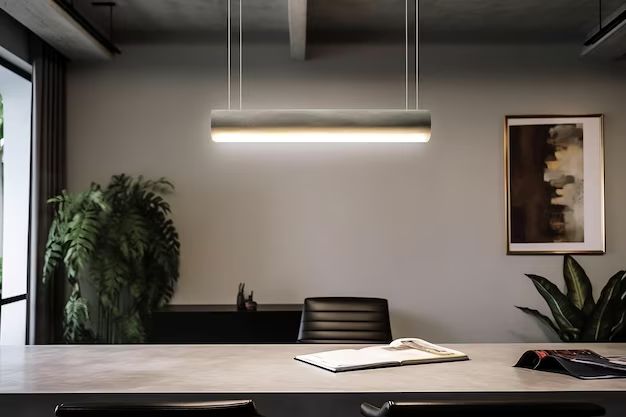When setting up a home office, proper lighting is crucial for productivity and eye health. With so many ceiling light options available, it can be tricky to determine which type is best suited for a home office environment. In this article, we will compare the most popular ceiling light types and examine the pros and cons of each to help you make an informed decision.
Page Contents
Fluorescent Lights
Fluorescent ceiling lights have traditionally been a popular choice for offices and commercial spaces. They are inexpensive to purchase and operate. Fluorescent lights diffuse light evenly across a space, reducing shadows and glare. This makes them well-suited for computer and paperwork tasks. However, fluorescent lights do have some downsides for home offices:
- Fluorescent lights have a “cool” or blue light tone that can be harsh on eyes over extended periods. They provide less natural lighting.
- They produce an audible humming noise that some find disruptive in a quiet home office.
- Most fluorescent fixtures cannot be dimmed.
Overall, the even distribution of light makes fluorescents a reasonable option for home offices on a budget. But the potential eye strain and lack of adjustability are factors to consider.
LED Lights
LED ceiling lights have surged in popularity in recent years. They are extremely energy efficient and long-lasting. Here are some benefits of LEDs for home offices:
- LEDs are available in a range of color temperatures from warm white to daylight. This allows you to customize lighting to suit your tasks and preferences.
- They can be dimmed to adjust brightness levels.
- LED fixtures often have superior light distribution compared to other types.
- LEDs do not produce any audible hum or noise.
- They do not contain mercury like fluorescents.
The main drawbacks of LED ceiling lights are upfront cost and heat management. LEDs are more expensive than fluorescent or incandescent options. And the electronics in LEDs can be sensitive to heat buildup. Proper fixture design is needed to dissipate heat.
Incandescent Lights
Incandescent bulbs cast a warm, natural light ideal for home offices. However, traditional incandescents have largely fallen out of favor due to energy inefficiency. Modern halogen incandescents improve efficiency somewhat, but still use more energy than LED or fluorescent options. Benefits of incandescent ceiling lights include:
- Incandescents provide a warm, inviting light tone perfect for long work hours.
- They can be easily dimmed to lower light levels.
- Bulbs are inexpensive to purchase.
Downsides of incandescent ceiling lights for home offices:
- They are the least energy efficient option, increasing electric bills.
- Incandescent bulbs have a shorter lifespan and need frequent replacing.
- Light distribution is less even than LED or fluorescent.
While less suitable overall, some may prefer the familiar glow of incandescents. Dimming capability helps make them more flexible.
Pendant Lights
Pendant lighting has become popular in home offices for providing directed, task-focused illumination. Pendant fixtures hang from the ceiling and cast light downward. Benefits include:
- Pendants can concentrate light right where it’s needed, over desks and work areas.
- A pendant fixture’s height is adjustable to customize lighting focus.
- Pendant lights create a stylish, decorative look along with functional task lighting.
- Many pendant designs are available to match office décor.
Considerations when using pendant lighting in home offices:
- Pendants alone may not provide sufficient overall ambient lighting. They work best paired with general ceiling lighting.
- Hanging pendant fixtures low enough can impede movement in smaller home offices.
- Fixtures positioned too high will fail to provide close task lighting.
Pendant lighting works best complementing another ceiling light type to balance task and ambient illumination. Positioning pendants correctly takes some trial and error.
Recessed Can Lighting
Recessed can lights, also known as downlights, have rebounded as an interior lighting option. Compared to old-style can lights, new LED recessed lighting offers advantages like:
- Recessed cans provide directed illumination without visible fixtures dangling from the ceiling.
- Adjustable LED trim kits allow modifying beam spread and light color.
- Can lights can concentrate illumination over work zones as needed.
- Separate switches or smart dimmers give control over individual cans.
Considerations for using recessed can lights in home offices include:
- Cans cast localized pools of light. Ambient lighting needs supplementing.
- Can housings require cutting holes into ceiling which is more complex install.
- Beam alignment needs adjusting to avoid glare on computer screens.
Recessed cans lend focused task lighting. Plus the ceiling remains clear of visible fixtures. Just be sure to diffuse and soften beams to prevent harsh glare.
Conclusion
So which is the best ceiling light for a home office? Here is a quick comparison:
| Light Type | Pros | Cons |
|---|---|---|
| Fluorescent | Inexpensive, even lighting distribution | Harsher light, humming noise |
| LED | Energy efficient, adjustable, long-lasting | Higher upfront cost |
| Incandescent | Warm light color, dimmable | Energy inefficient, short lifespan |
| Pendant | Directed task lighting | Insufficient ambient lighting |
| Recessed Can | Discreet, focused illumination | Potential for glare |
For their combination of low cost, energy efficiency, adjustability, and light quality, LED ceiling lights emerge as the best all-around choice. They provide the brightness and customization needed for office work without straining eyes. And the wide selection of LED fixtures gives plenty of options to suit personal style.
But every home office and user has unique needs. Other light types like fluorescents or pendants could be better suited depending on budget, room layout, and the tasks performed. Any option is viable with proper positioning and lighting accessories like diffusers or dimmers. The key is evaluating your office lighting needs and selecting fixtures to meet them for enhanced productivity and comfort.
